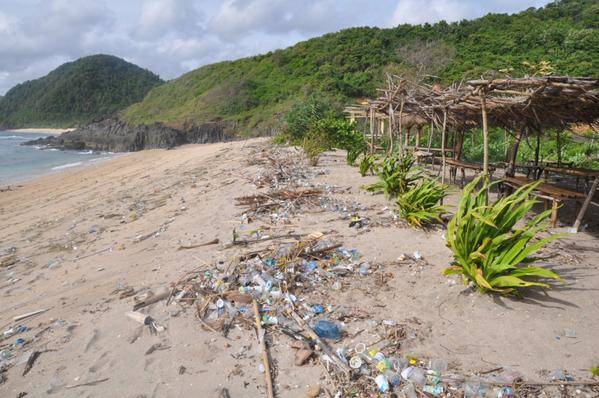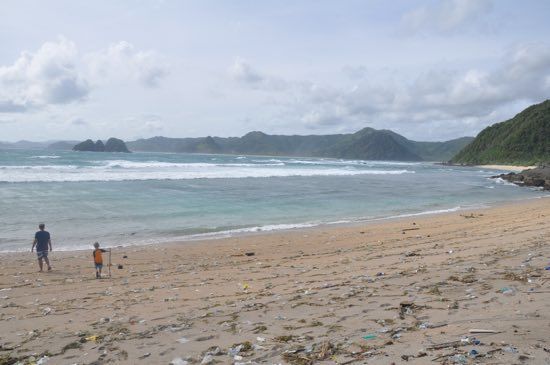Is THIS the Biggest Environmental Issue Facing Indonesia?
Ladies, gentlemen, environmentalists. Allow me to introduce the Aqua cup, or “Aqua gelas”, a single-use, single-cup serving of water that is designed to be thrown away. This, if you believe some foreigners, is the single biggest environmental issue – quite possibly the biggest issue of ANY KIND AT ALL – facing Indonesia.

Yep, that’s right. The mass destruction of rainforest and peat swamp is making a nation that’s home to up to 15% of plant, mammal and bird species one of the world’s largest producers of greenhouse gases. And we’re worrying about the Aqua cup?!
Admittedly, Indonesia is home to more than a quarter of a billion people, who collectively consume and then discard a hideous number of Aqua cups. The bloody things are ubiquitous: in government offices, lawyer’s office, dentists, hospitals and schools, at weddings, funerals, ceremonies and parties.
But… Why the merry hell are people who have *flown* into Bali on their holidays getting het up about the environmental impact of the Aqua cup?! (A return flight from Bali to Perth generates over a tonne of CO2.) Surely not for the selfish reason that the litter spoils the beach?!

Now, don’t get me wrong. I’m every bit as opposed to the Aqua cup as the next bule. While not quite as evil as the fruit drink designed to make a pretty flower when kids threw it on the ground and stamped on it, the Aqua cup is wrong on so many levels, both symbolic and actual, that it’s almost impossible to express.
In the Aqua cup, we have a multinational (Danone) actively marketing water to a country that does not yet have clean drinking water, effective waste disposal or anything by way of recycling in the single most environmentally unfriendly fashion possible. Until recently (and quite often even now) Indonesian wrappings were biodegradable – banana leaves, woven palm, just possibly paper – so, in most of the archipelago, the cups are treated the same way. They are thrown on the street, then washed down to the ocean, or occasionally burned, which is arguably even worse.
The very concept of the Aqua cup is environmentally repellent: a profligate waste of fossil fuel and emissions to produce plastic destined to litter and pollute the oceans. The fact that a tiny proportion of these cups find a second life when scavenged – they are repurposed to hold small portions of cooking oil for sale – does not make it less disgusting.
And Danone’s claim that it is “committed to conduct business responsibly for environment and society” – on a page devoted to Aqua that mysteriously omits the Aqua cup – makes me want to spit. Still of all the problems Indonesia has, let alone of all the environmental issues Indonesia faces, the Aqua cup is not a priority.

My personal Aqua cup epiphany happened on Christmas Day. My parents were visiting, so we’d ordered a babi guling (sucking pig). Thanks to a Hindu ceremony before Christmas, the smallest available pig was a whopping 20kg, so we’d invited my neighbourhood (lingkungan) over to share it.
There I was, stocking up dutifully on all those things that Indonesians generally drink and foreigners generally don’t, like Teh Botol “iced tea” and Benylin-flavoured Fanta Stroberi. In Indonesia, the colour “fanta” refers to the neon-pink of this noxious product, which is the only drink I can think of that is actually improved by mixing with the now-banned Cap Tikus (“Rat Brand”), a Sulawesi moonshine used by locals as an alternative to petrol during the recent price hikes.
“I should get Aqua cups,” I said to my Ma. “But I hate Aqua cups! They’re the devil’s work! I’m going to leave glasses by the water dispenser and people can serve themselves.”
Anyone who has ever lived in Indonesia can guess how this one ends.
Dear Putu, the wife of my lingkungan head, brought round an armful of Aqua cups for the hopeless bule (as well as the ready-cooked rice I – gasp! – did not have to hand, since we thought some might come with the pig, and, what with not being Indonesian, I don’t keep great vats full of cooked rice in the kitchen in case someone’s hungry).
Most of Putu’s Aqua cups are still in my cupboard: I did ask her to take them with her, but, no, they were a gift. Still even the most superficial carbon footprint comparison – or simply adding up the ten or so flights Zac and I take each year – tells me that the person who needs to get their environmental house in order is not Putu, but me.
Want to help get rid of Aqua cups? Bottle for Botol is trying to get water bottles into Indonesian schools in place of the dreaded Aqua cups; or, of course, you could contact Danone.
The lead image is mine; both Lombok beach pictures are from Travelfish.

Great article, and yeah it is pretty disgusting.
I’d also like to add this one foreigner who LOVES teh botol. Can’t quite see why other foreigners don’t get it.
Thanks, Geoff. I rarely drink tea – occasionally green tea – and don’t add sugar to anything if I can help it (though I’ll obviously drink three-in-one if that’s the only caffeine I can find), so teh botol is a double-bleurgh for me.
I saw these *all over* in Jordan too a few weeks ago, and was kinda surprised by them as I’d never seen them before in the developing world (or at least places where you wouldn’t drink the water) and they seemed like an awful idea. And now I’m sad reading this. 🙁
That’s interesting. They weren’t in Jordan when we were there (2012, or thereabouts) – I associate them very much with Indonesia, though, of course, they could be so successful here that they’re being rolled out globally. It’s also very striking because of the cultural attitude to litter here, and the rivers, and the rainy season, and the currents: on islands like Bali and Lombok, it really does come back to bite you, whereas with a population density like that of Jordan, you can probably get away with it for longer.
Flights obviously leave a huge footprint but I think the larger point to be made in this case invoves 1) the treatment of water as a relatively expensive commodity in general and 2) that plastic is a monstrous problem everywhere, one accentuated in the developing world because the recycling/disposal systems are so inadequate or non-existent as you say. The trash is everywhere.
The entire notion of bottled water has become so irksome because the bottling process is so wasteful and is often marketed in places where tap water is in fact just fine. And at prices that are oftentimes more expensive than petrol. The latter may not be the case in Indonesia, as you point out, but does apply to many places around the planet.
But yeah, maybe aim for a couple less flights in the next year. 🙂
I hear ya on the bottled water in the developed world – the notion that one would pay to drink water when you can drink what comes out of the tap is just plain ludicrous. And yet, people do. Your point 1 hits the nail on the head: the commodifying and branding of WATER is what’s so particularly vile about all this.
Water pricing here is interesting. Luxury foreign waters and sparkling waters are very expensive – $4 for a litre of Equil. But the 19-litre (5-gallon) jugs that I use in my kitchen cost $1.20 each for a refill. Petrol, by way of comparison, is around 0.60 for a litre.